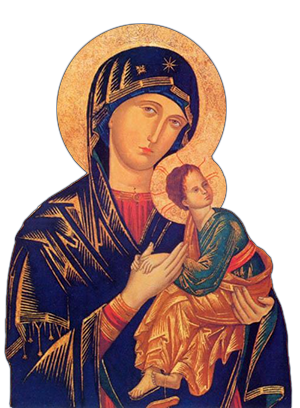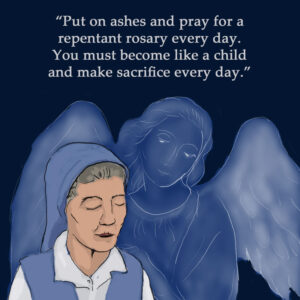Father Linus Clovis: the Lamb of God
The next day, he saw Jesus coming towards him and said, behold the Lamb of God who takes away the sin of the world. This is he of whom I said, after me comes a man who ranks before me, for he was before me. I myself did not know him, but for this I came baptizing with water that he might be revealed to Israel. And John bore witness. I saw the spirit descend as a dove from heaven and remain on him. I myself did not know him but he was sent me to baptize with water said to me, he on whom you see the spirit descend and remain, this is he who baptizes with the Holy Spirit. And I have seen and have one witness, that this is the Son of God.
Saint John begins his Gospel in the prologue by saying, there was a man sent by God, his name was John. And he came to bear witness to the light. And then he goes on to say how he bore witness to the light.
John himself was not light. He came merely to bear witness to the light. And he bore witness to the light, first of all, officially, publicly, and juridically. This is when the Jews sent priests and Levites from Jerusalem to ask him, who are you?
And so, John bore witness to Our Lord, that while somewhat was absent, now, we’re told the next day, he bore witness to him as he’s present. And, in verse 29, the Evangelist says, the next day he saw Jesus coming towards him. So, the first thing is, John was continually bearing witness, he did not cease. He bore witness once to the priests (the Levites who came from Jerusalem), and now he bears witness again (the next day).
And so also should we; we should be continually bearing witness (testimony) to Our Lord. In other words, we should praise the Lord in the morning and the evening and all the day long. He saw. So this is the first thing. He was watching. And whom did he see? He saw Jesus–he didn’t just see Jesus–he saw Jesus coming. And this, in fact, is what we should be doing continually: waiting and watching to see when our Blessed Lord will return.
He tells us that we should be like servants ready to open the moment the lord knocks, and so this means spiritual vigilance and above all watching our paths and watching for the enemy, for, Saint Peter tells us that your enemy, the devil, is roaming the earth looking for someone to devour.
But we watch not for the lion that devours, but rather for the lion of the tribe of Judah; we watch for the lamb.
And as John sees our Blessed Lord approaching, he said behold the Lamb of God, and so he sees immediately who it is, and he calls him the Lamb of God who takes away the sin of the world. And this, in fact, is the very reason why our Blessed Lord came: to take away the sin of the world. He’s called the Lamb of God
There were five animals that were acceptable as sacrifice in the Temple; there was a heifer (the cow), the bull, there was the goat, there was the sheep–and it could be a male sheep (a ram), or it could be a female sheep (the ewe), or it could be the young sheep (the lamb). So, these three belong to the earth. And there were two other animals which could be offered for sacrifice, and these belong to heaven; the dove and the pigeon. And they represent, of course, the two natures of Our Lord: his human nature, which comes from the earth, and his divine nature, which is symbolized by the birds of heaven. And these can be offered in sacrifice.
But Saint John speaks specifically of the Lamb of God. And we ask, why the lamb? Because the lamb was the only sacrifice–the only animal–that was sacrificed twice a day; in the morning and in the evening. So, we had the morning sacrifice and the evening sacrifice. The others were offered at specific times and for special reasons, but the lamb was offered at the beginning, which again represents Christ, who is the beginning of our salvation and in the evening, for he is the end of our redemption. So Saint John appropriately calls him the Lamb of God.
And yet there are the other animals. While they do indeed symbolize Christ, more correctly, perhaps, they symbolize us – each and every one of us individually, since they’re offered separately. And so the sacrifices of the Saints are also joined to the sacrifice of Christ, and, in particular, the bull was the sacrifice associated with the priests. And we can equally look at the other sacrifices for the various ranks of saints.
So, Saint John sees he who takes away the sin of the world. He doesn’t say sins, but rather, the sin: the original sin from which all others spring. So, in a certain sense, the Baptist is telling us that Christ erases all sin in removing the original sin.
He goes on to say, this is he of whom I said after me comes a man who ranks before me, for he was before me. When did he say this? Well, he said it when the priest came to ask him, who are you? So, he says, here he is, this is the man. He calls him a man according to his human nature. Yet, at the same time, he proclaims his divinity: who ranks before me. Why? For he existed before me. He’s proclaiming his divine nature because, as we know, Our Lord was conceived six months after John. So, in his human nature, he follows John, but, in his divine nature, he pre-existed John. And so, John can say he ranks before me.
He goes on to say, I myself did not know him. He did not because, when Our Lord was born, John was an infant – just six months old, and, when all the mysteries of Our Lord’s infancy were completed, John would still be a child. And even then, as a child, he went off into the wilderness. So, he did not know Our Lord according to his human nature, but for this I came baptizing with water that he might be revealed to Israel.
And so, John gives us a reason why he came to baptize: to reveal the light, to point him out, behold the Lamb of God. And we’re told that John bore witness. He bore testimony.
He goes on further to say, I saw the spirit descend as a dove from heaven and remain on him. And this, again, is another testimony which we know from St. Matthew’s Gospel occurred at the baptism of Our Lord, when the voice of the Father is heard: “this is my son, the beloved.”
The Holy Spirit descends in bodily form of a dove, and Our Lord himself is present. So, the Blessed Trinity is revealed at that moment. John is the one who confesses it, who bears testimony to it.
He goes on to say, he remained with him because, indeed, we do receive the Holy Spirit, but we are, sometimes, often, drive the Holy Spirit away by mortal sin, or we do not receive the fullness of the grace of the spirit because of venial sin. But on Christ, in whom there is no sin, the Holy Spirit remains.
The Baptist goes on again: I myself did not know him, but he who sent me to baptize with water said, he on whom you see the Spirit descend and remain, this is he who baptizes with the Holy Spirit. So John is, again, pointing out, as he did to the to the priests and the Levites and the Pharisees, that his baptism was imperfect, and there was one greater than he who would give a more perfect baptism. And he implies, he shows, he points, he testifies; that this, in fact, is the Lamb of God.
And so, he continues and says, I have seen and have born witness that this is the Son of God. And so, he makes a proclamation again of Our Lord’s divinity. He didn’t say this is a son of God, but this is the Son of God; the unique Son of God, the only begotten of the Father, The Word who was in the beginning, and when, in our time, has been made flesh for the remission of our sins, for our rebirth in grace, for us to have eternal life.
Video courtesy of Family Life International, transcript provided by WQPH



